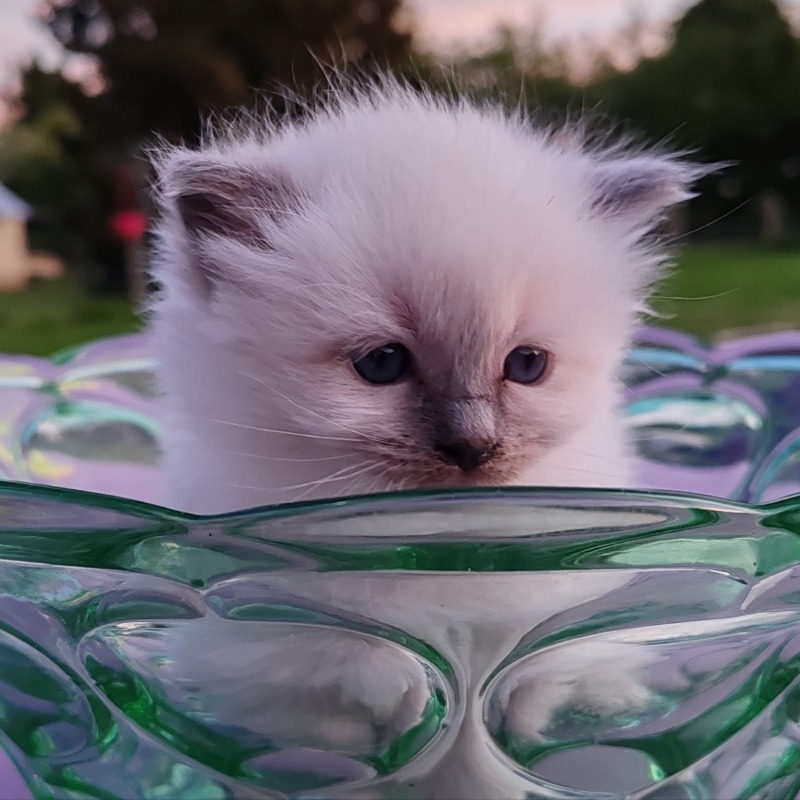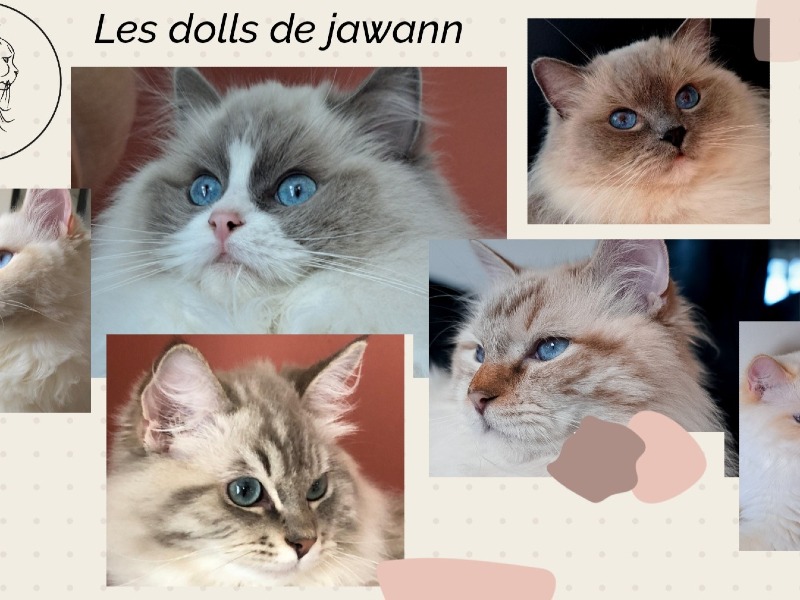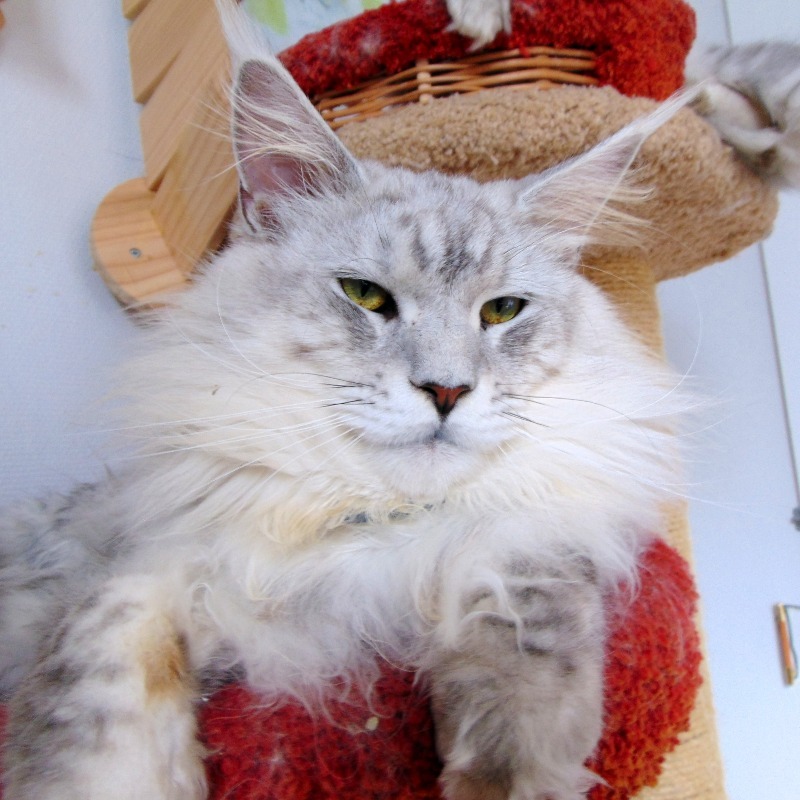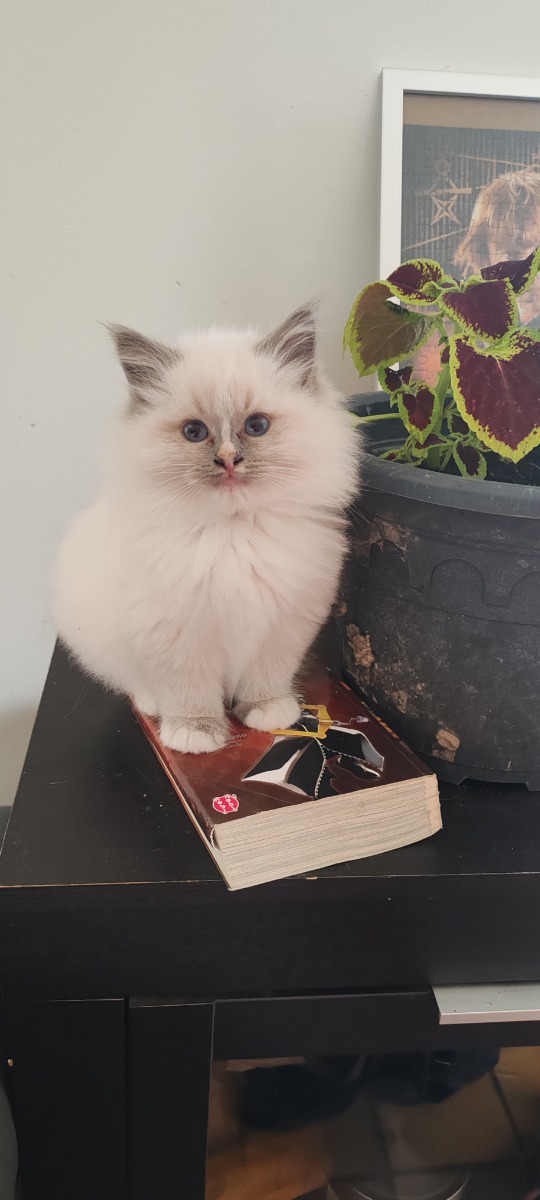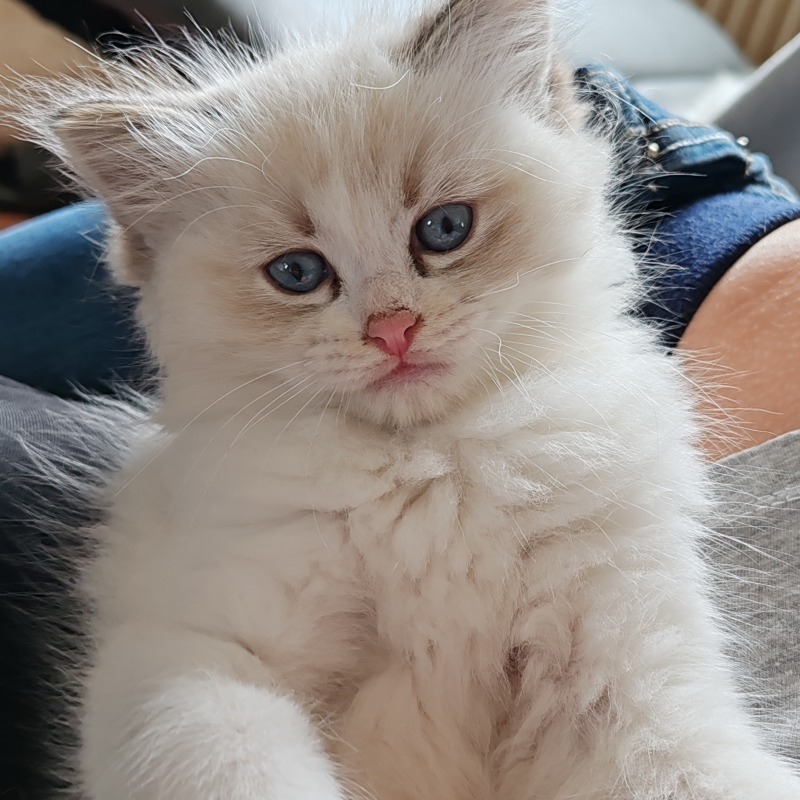Ragdoll
Welcome to our page dedicated to the breed of cat ragdoll!
Here, you will find all the useful information about ragdoll. This descriptive profile will allow you to discover the aspects of this breed. You can notably consult information about the average price, monthly and annual upkeep expenses, their health, name ideas, as well as their official recognition by competent authorities.
Explore this page to discover everything you need to know.
Overall description of the breed
The Ragdoll, a breed of cat with gentle eyes and luxurious fur, has an intriguing history dating back to the 1960s in the United States, specifically in the state of California. This remarkable breed derives its name from one of its most distinctive features: the tendency of Ragdoll cats to completely relax and go limp when picked up, hence the term "Ragdoll."
Its history begins with Ann Baker, a passionate cat breeder from California. In the 1960s, she owned a semi-longhaired white cat named Josephine. According to legend, Josephine was hit by a car and survived with a few quirks, including the tendency to go limp when picked up. Ann Baker recognized the potential of this unique trait and started developing a new breed.
The ancestors of the Ragdoll breed include cats with various coat colors, Persians, Burmese, and Birmans. Ann Baker established a selective breeding program to create cats with gentle and calm personalities, as well as luxurious coats. The distinctive features of the Ragdoll include its large and muscular build, triangular head with soft contours, oval and expressive eyes, and long silky fur.
Morphologically, the Ragdoll is a large cat with a well-proportioned body. Their legs are medium-sized, their paws are broad, and their eyes are typically blue. Their fur consists of a soft undercoat and longer, silky fur on the surface. The most common coat colors are Seal, Blue, Chocolate, and Lilac, with various pattern variations like Colorpoint, Mitted, and Bicolor.
The character of the Ragdoll is perhaps its most precious asset. These cats are known for their gentle, affectionate, and relaxed nature. They are often described as loyal companions and are family-friendly, as they tend to be sociable and tolerate children and other pets. The characteristic trait of going limp when picked up has made this domestic feline a beloved cuddle companion for many owners.
In terms of measurements, Ragdoll cats vary in weight and size based on gender and lineage. On average, males weigh between 5.5 and 9 kg (12 to 20 lbs), while females weigh between 4 and 6.5 kg (9 to 14 lbs). In terms of size at the shoulder, Ragdolls typically measure between 25 and 40 cm (10 to 16 inches).
The popularity of the Ragdoll has grown over the years and has been officially recognized by various renowned feline organizations. The Ragdoll Fanciers Club was founded in 1971 by a group of dedicated breeders to promote and preserve the breed. In 1993, the Ragdoll was officially recognized by The International Cat Association (TICA), contributing to its international visibility and fame.
In conclusion, the Ragdoll embodies the perfect combination of majestic appearance and affectionate temperament. The intriguing history, coupled with attractive physical and behavioral traits, has made it one of the most coveted and sought-after cat breeds worldwide. With its calm and loving nature, the Ragdoll continues to capture the hearts of cat lovers and remains a popular and cherished breed for years to come.
Awareness of acquiring an animal
Each animal is a sensitive being, deserving love, attention and care.
When you choose to adopt an animal, you take on the responsibility of ensuring its health and well-being throughout its life.
To learn more about animal welfare, we invite you to consult our FAQ by clicking the button below:
Origins
The Ragdoll is a breed of cat originating from the United States. It was developed in the 1960s by Ann Baker, a Californian breeder. This breed is the result of crossing a longhaired cat with Birman and Persian cats. The goal was to create a cat with an exceptionally gentle and affectionate temperament, with a distinctive appearance. The name "Ragdoll", which means "ragdoll" in English, comes from their tendency to completely relax when picked up, like a doll. Ragdolls quickly became popular for their sociable nature and majestic appearance. The breed has gained recognition and popularity not only in the United States but also worldwide, thanks to its impressive physical characteristics and its placid and affectionate temperament.
History
The history of Ragdolls began in the 1960s, in Riverside, California. Ann Baker, a passionate cat breeder, started experimenting with crosses with a white cat named Josephine. This cat, after a car accident, reportedly developed a particularly docile and relaxed nature. By crossing Josephine with other cats with similar traits, Baker was able to establish the characteristics that are typical of Ragdolls today. In 1965, Ann Baker registered the breed under the name Ragdoll and established strict criteria for its breeding. She also created a breeding franchise to control the quality of the lines. Since then, the breed has gained popularity and spread worldwide, with clubs and associations dedicated to its breeding and promotion.
Standard
The Ragdoll breed standard is defined by several distinctive characteristics. Ragdolls are large cats, with a long and muscular body. Their head is broad with full cheeks and large, oval eyes of deep blue color. The ears are medium-sized, slightly rounded, and tilted forward. The body should be well-proportioned with sturdy legs and a long, bushy tail. Their coat is medium-length, soft and silky, with a rich ruff around the neck. The colors and patterns are varied, including colorpoint, mitted, and bicolor, with color variations such as seal, blue, chocolate, lilac, and others.
Physical characteristics
Ragdolls are large cats, with males weighing between 5.4 and 9 kg and females between 4.5 and 6.8 kg. Their bodies are long and muscular, with a broad chest and strong legs. Their coat is medium to long, very soft and silky. They have a thick ruff around their neck, and their fur is shorter on the front legs. The coat colors vary, including seal, blue, chocolate, lilac, red, and cream. The patterns can be colorpoint, mitted or bicolor. Ragdolls' eyes are always blue, ranging from light blue to deep and intense blue, adding to their charm.
Character
The Ragdoll is known for its exceptionally gentle and placid temperament. This cat is extremely affectionate, constantly seeking human contact and strongly bonding with its owners. Ragdolls are generally calm and tolerant, making them ideal for families with children or other pets. They are not aggressive and adapt well to indoor environments. Their relaxed and docile nature makes them easy to live with and low-maintenance in terms of behavior. They enjoy following their owners around the house and often participate in family activities, providing a calming and constant presence.
Life expectancy
Ragdolls have a relatively long life expectancy for a cat breed, usually between 12 and 15 years. With proper care, balanced nutrition, and regular visits to the veterinarian, some Ragdolls can even live longer. Their longevity is influenced by various factors including genetics, breeding quality, and lifestyle. It is essential to provide them with quality nutrition, a safe environment, and attention to maximize their lifespan and well-being.
Exercise and activity needs
Although Ragdolls are fairly calm cats, they need exercise and stimulation to stay healthy. They enjoy interactive games with their owners, such as chasing games or feather toys. Cat trees and scratching posts are also important for them to climb and play. However, they are not as active as some other breeds and often prefer to relax or follow their owners around the house. It is essential to provide them with activities to prevent boredom and obesity.
Recommended diet
Ragdolls require a high-quality diet, balanced in proteins, fats, and essential nutrients. It is recommended to feed them premium kibble or wet food specially formulated for large breed cats. The monthly cost of their food can vary between 30 and 50 euros, depending on the brand and type of food chosen. It is crucial to monitor their weight and adjust their diet according to their specific needs to avoid overweight and health problems.
Training and obedience
Ragdolls are intelligent and receptive cats, making them relatively easy to train and educate. They can learn simple commands, such as coming when called or using a scratching post instead of furniture. Consistency and patience are key to success, using positive reinforcement like treats and praise. They adapt well to indoor life and appreciate a stable and secure environment. Ragdolls can also be trained to walk on a leash, which can provide them with additional stimulation while being safe.
Behavior with children
Ragdolls are known for their gentle and tolerant nature, making them particularly suitable for families with children. They are patient and rarely aggressive, allowing children to play with them without risk. Ragdolls enjoy companionship and interaction, and their placid temperament makes them less likely to react negatively to sudden movements or noise. However, it is important to teach children to respect the animal and interact with it appropriately to ensure harmonious cohabitation and avoid any stress for the cat.
Compatibility with Other Animals
Ragdolls are generally very sociable and get along well with other pets, including dogs and other cats. Their gentle and non-aggressive nature makes it easy for them to integrate into a multi-pet household. They enjoy companionship and can even form close bonds with other animals, often sharing resting spaces and playing together. However, it is important to introduce them gradually and monitor initial interactions to ensure that all animals adapt well to each other's presence.
Grooming needs
Ragdolls have a medium-length silky coat that requires regular maintenance to prevent knots and tangles. Brushing two to three times a week is recommended to keep their fur in good condition and reduce shedding. During shedding season, more frequent brushing may be necessary. Ragdolls do not have a dense undercoat, which reduces the risk of matting compared to other long-haired breeds. It is also important to regularly check and clean their ears, trim their nails, and maintain good dental hygiene.
Health
Ragdolls are generally healthy, but they can be prone to certain genetic conditions. Common health issues include hypertrophic cardiomyopathy (HCM), an inherited heart disease, and urinary crystals. It is crucial to choose responsible breeders who test their breeding cats for these conditions. Ragdolls can also be sensitive to obesity, so a balanced diet and regular exercise are essential. Regular vet visits and up-to-date vaccinations help maintain their health and prevent diseases.
Average price
The price of a Ragdoll can vary considerably depending on several factors, including lineage, pedigree, and the reputation of the breeder. Generally, the cost of a Ragdoll kitten ranges between 800 and 1500 euros. Cats from championship lines or with exceptional characteristics can cost even more, sometimes up to 2000 euros or more. It is important to note that this initial cost does not include ongoing expenses related to care, food, and veterinary fees.
Expenses
On average, monthly expenses for a Ragdoll can vary between 50 and 100 euros. This estimation includes food, litter, regular veterinary care, grooming products, and toys. Costs can increase in case of unforeseen health problems or specific dietary or medical care needs. It is also advisable to budget for annual vet visits, vaccinations, and preventive treatments against parasites.
Name ideas
When choosing a name for your Ragdoll, you can opt for names that reflect their gentle and majestic nature. Here are some suggestions: Luna, Oliver, Bella, Leo, Daisy, Simba, Lola, Milo, Ruby, Jasper, Chloe, Max, Sophie, Charlie, Mia, Finn, Lucy, Oscar, Nala, and Zoe. These names are popular and fit well with the affectionate and elegant personality of Ragdolls. You can also choose a unique name that matches your cat's specific personality or physical characteristics.
Legislation and regulation
In France, Ragdolls are not classified in a specific category of regulations. However, as with all pets, it is important to respect local regulations regarding pet ownership, including laws on identification (microchip or tattoo) and vaccination. There are no specific restrictions regarding breeding or selling Ragdolls, but it is recommended to choose registered breeders who adhere to ethical standards. Feline associations and breed clubs can provide additional information on best practices.
Official recognition
Ragdolls are recognized by many feline organizations worldwide. Among the main associations are the Fédération Internationale Féline (FIFe), the Cat Fanciers' Association (CFA), The International Cat Association (TICA), and the Governing Council of the Cat Fancy (GCCF). In France, the Livre Officiel des Origines Félines (LOOF) is the official organization for recognizing cat breeds, including Ragdolls. These associations establish breed standards and organize shows and competitions to promote Ragdolls and other cat breeds.
Pedigrees
Ragdolls with an official pedigree can be registered with various breed clubs in different countries. In France, LOOF is the main organization for pedigree registration. In the United States, CFA and TICA are the main associations. In Great Britain, GCCF is responsible for pedigree registration. These clubs maintain databases of pedigrees and issue pedigree certificates to ensure the authenticity and quality of purebred cats. They also provide information on licensed breeders and breed standards.
Destination and usage
Ragdolls are primarily bred to be pets because of their gentle and affectionate nature. Their calm behavior and compatibility with children and other animals make them popular choices for families. They can also participate in cat shows and beauty contests due to their majestic appearance and defined breed characteristics. While seldom used for specific purposes such as hunting or guarding, Ragdolls bring great value as companions and loving family members.
Prohibitions
There are no specific restrictions regarding the possession of Ragdolls in France or in most other countries. However, as with any pet, it is crucial to comply with local and national laws regarding animal welfare. This includes requirements for care, vaccination, identification, and disease prevention. It is also important not to let them roam outside unsupervised, as they may be vulnerable to dangers such as traffic or wild animals. It is recommended to keep Ragdolls indoors for their safety.
Breeders of Ragdoll
Want to see more breeders of Ragdoll?
Check out the page of our directory listing all breeders of RagdollClassified Ads of Ragdoll
Breed clubs of ragdoll
No of ragdoll breed clubs are currently registered on Preeders.
If you would like to highlight your breed club, sign up for free now and be the first to appear on this page.

